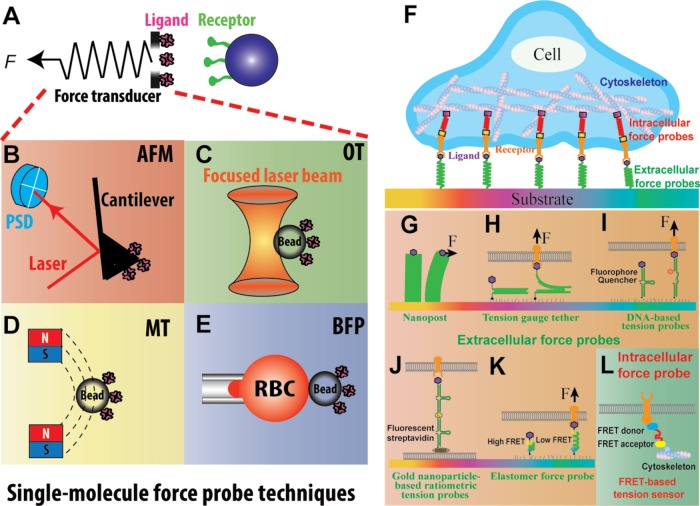FIGURE 3:
Single-molecule force probe techniques (A–E) and microscopic probes for cell tractions and intracellular forces (F–L) techniques. (A) A generic force probe that applies forces (F) to the receptor–ligand bond spanning a surface and a force transducer. (B) Atomic force microscopy (AFM): force is applied to individual molecules tethered between a functionalized cantilever and a surface. (C) Optical tweezers (OT): a protein-coated bead is held by a laser beam. (D) Magnetic tweezers (MT): permanent/electrical magnets are used to manipulate a protein-coated magnetic bead. (E) Biomembrane force probe (BFP): the protein-coated bead is attached to the apex of a micropipette-aspirated red blood cell (RBC). (B–E) Force is determined respectively by cantilever deflection (B), bead displacement (C), gradient of the magnetic field (D), and RBC deformation (E). (F) Extracellular and intracellular tension sensors allow microscopic observation of endogenous forces experienced by different proteins. (G) Nanopost: the deflections of the polydimethylsiloxane posts reflect the lateral components of tractions exerted by adhered cells. (H) Tension gauge tethers (TGTs): DNA strands with defined tension tolerances are repurposed to test the tension required to activate cell adhesion. (I) Molecular tension-based fluorescence microscopic probe. The fluorophore and quencher are coupled to report the force-induced unfolding of the DNA hairpin, thereby unquenching the fluorescence to report the molecular forces. (J) Gold nanoparticle-based ratiometric tension probes on supported lipid bilayer monitor hairpin opening due to force while controlling for clustering of mobile ligands using a secondary fluorescent readout. (K) Elastomer force probes report drop in FRET signal due to the elongation of the nanospring domain upon force application. (L) Intracellular force probes genetically inserted into domains of intracellular proteins allow force measurement of key domains involved in mechanotransduction inside the cell.

